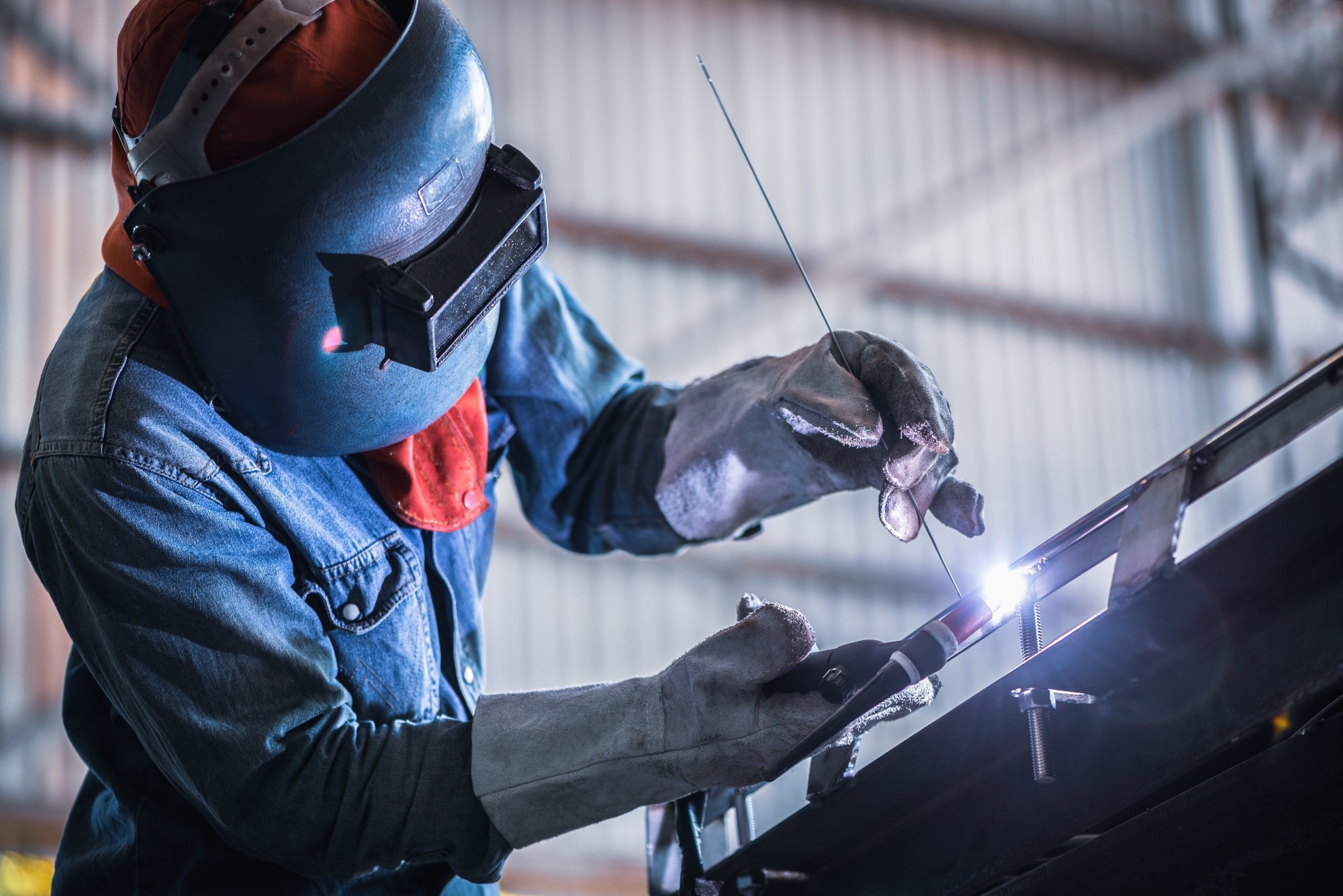Superaustenitic stainless steels are a subclass of austenitic stainless steels developed for use in highly corrosive and high-temperature environments. They are often selected when conventional stainless steels are insufficient and fully nickel-based alloys are cost-prohibitive.1
 Image Credit: N_Sakarin/Shutterstock.com
Image Credit: N_Sakarin/Shutterstock.com
These steels are characterized by their high alloy content, typically including elevated levels of molybdenum (Mo), nickel (Ni), chromium (Cr), and nitrogen (N). For instance, the alloy 254SMO contains approximately 20 % Cr, 18 % Ni, 6 % Mo, and 0.2 % N. This composition provides enhanced resistance to general, pitting, and crevice corrosion, especially in chloride-rich and acidic environments.
Chromium supports the formation of a passive oxide layer, while nickel stabilizes the austenitic structure and improves resistance to stress corrosion cracking. The combined effect of Mo and N further improves localized corrosion resistance. Alloys of this type often have a Pitting Resistance Equivalent Number (PREN) above 40, supporting their use in marine, offshore, and chemical processing applications.2
Despite their complex composition, superaustenitic stainless steels offer good weldability and formability using conventional techniques such as tungsten inert gas (TIG) and metal inert gas (MIG) welding. Their austenitic microstructure contributes to ductility and limits undesirable phase transformations during thermal processing, thereby reducing the risk of brittleness or cracking.1
Mechanically, they exhibit high tensile strengths (typically 600–800 MPa) and yield strengths (around 300–400 MPa). These properties are retained at elevated temperatures, along with resistance to scaling and oxidation. This thermal stability makes them suitable for prolonged use in high-temperature service environments.3
What is Superaustenitic Stainless Steel Used For?
Chemical, Petrochemical, and Paper Industries
Superaustenitic stainless steels are widely used in reactors, acid-handling systems, and heat exchangers that operate in the presence of aggressive chemicals such as sulfuric, hydrochloric, and nitric acids.
They retain their mechanical integrity and corrosion resistance even at elevated temperatures. In fossil fuel power plants, they are used in flue gas desulfurization (FGD) systems. They can protect absorbers and scrubbers from corrosive condensates and acidic gases.
Similarly, in the paper industry, they are used in equipment such as digesters, bleaching towers, and washers that function in acidic and chlorinated environments.1,3
Marine Structures and Desalination Plants
Superaustenitic steels are highly suitable for components exposed to seawater, such as piping systems, valves, and heat exchangers, where high chloride content accelerates corrosion. In desalination plants, where equipment is subjected to concentrated brine and high pressure, these steels provide durability and minimal maintenance requirements.2,5
Food and Pharmaceutical Industries
In food processing and pharmaceutical systems, these alloys are utilized in tanks, pipelines, and processing units where cleanliness and corrosion resistance are essential. Their ability to withstand both organic and inorganic acids, along with their smooth surface, supports hygienic operation and ensures consistent product quality.4
Nuclear Industry
In nuclear environments, superaustenitic stainless steels are used in applications such as spent fuel pools, reprocessing systems, and storage containers for radioactive materials.
Their excellent mechanical strength, resistance to radiation-induced degradation, and corrosion performance in chemically aggressive settings make them a reliable choice for long-term use in critical infrastructure.1
Download your PDF copy now!
Superaustenitic Stainless Steel: Grades
Several specialized grades exist, each tailored for specific industrial applications:
- 254SMO (UNS S31254) is known for its strong resistance to pitting and crevice corrosion, thanks to its high molybdenum content. With a PREN value over 42, it is well-suited for harsh environments like seawater systems, offshore structures, oil and gas facilities, and desalination plants.
- AL-6XN (UNS N08367) provides excellent resistance to chloride-induced corrosion and has good weldability. These qualities make it a preferred choice in the food processing, pulp and paper, and marine industries. Its low carbon content also helps resist intergranular corrosion after welding, supporting long-term structural integrity.
- UNS N08926 (Alloy 926) is closely related to AL-6XN, with slightly higher molybdenum content. It offers strong protection against both pitting and intergranular corrosion. Common applications include power plant condensers, seawater piping, and chemical processing equipment.
- UNS N08031 (Alloy 31) is designed for extremely harsh chemical environments. It contains higher levels of chromium and nickel, delivering exceptional corrosion resistance and mechanical strength in both acidic and alkaline conditions. This grade is particularly effective in industries dealing with aggressive substances like phosphoric, sulfuric, and nitric acids. As a result, it is widely used in chemical processing systems and flue gas cleaning units.6
Grade selection depends on the specific service environment, including temperature, mechanical loads, corrosion type, and fabrication or welding constraints. Choosing the right grade ensures long-term performance, reduced maintenance, and enhanced safety.
Ready to Choose the Right Grade?
Superaustenitic stainless steels deliver outstanding performance in the toughest environments, but selecting the correct grade is only part of the equation. Knowing how to identify and verify stainless steel grades is essential for ensuring material reliability, safety, and cost-effectiveness in your application.
Explore our next guide: How to Test Stainless Steel: A Guide to Identifying Steel Grades
References and Further Reading
1. Fushun Special Steel Co. (2023). The Development History of Super Austenitic Stainless Steel - Evolution, Technology & Future Trends. https://www.fushunspecialsteel.com/development-history-of-super-austenitic-stainless-steel/
2. Li, B. et al. (2023). Studies on the Cooperative Influence of Cr and Mo on the Pitting Corrosion Resistance of Super Austenitic Stainless Steels. Materials, 16(23), 7397. https://doi.org/10.3390/ma16237397
3. Wei, L. et al. (2023). Prediction of High-Temperature Creep Life of Austenitic Heat-Resistant Steels Based on Data Fusion. Metals, 13(9), 1630. https://doi.org/10.3390/met13091630
4. Zaffora, A., Di Franco, F., & Santamaria, M. (2021). Corrosion of stainless steel in food and pharmaceutical industry. Current Opinion in Electrochemistry, 27, 100760. https://doi.org/10.1016/j.coelec.2021.10076
5. Shokri, A., & Sanavi Fard, M. (2022). Corrosion in seawater desalination industry: A critical analysis of impacts and mitigation strategies. Chemosphere, 307, 135640. https://doi.org/10.1016/j.chemosphere.2022.135640
6. Nickel Institute. (2001). High-Performance Stainless Steels. https://nickelinstitute.org/media/1702/highperformancestainlesssteels_11021_.pdf
Disclaimer: The views expressed here are those of the author expressed in their private capacity and do not necessarily represent the views of AZoM.com Limited T/A AZoNetwork the owner and operator of this website. This disclaimer forms part of the Terms and conditions of use of this website.